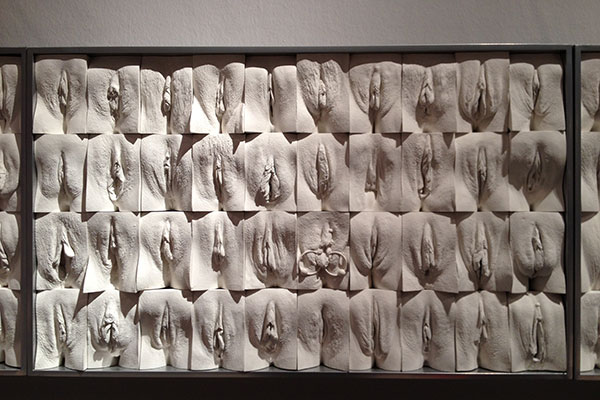Let Us End With Some Porn
Much of this is the result of pornography. Pornography has hijacked our mental images in many strange, and often-overlooked, ways. Consequently, the art world is beginning to explicitly tackle porn in an attempt to raise awareness about its influence on social relationships in the twenty-first century – such as our obsession with hairlessness – and force the topic into the conversation spotlight.
In 2006, The Guardian published an article contending that artworks with pornographic themes were no longer shocking. The central argument was essentially “oh, porn is so mainstream. Move on, ‘art’; it’s time to head back to the studio. Your obsession with porn is starting to get boring.”
Why, then, were Ed Templeton’s photos of teenagers kissing only exhibited last year? Why do pictures of – and even references to – vaginas continue to be the subject of such disgusted and dismissive reactions? Think about Terry Richardson’s collaboration with Miley Cyrus. Porn has subtly infiltrated our communities, and is making its presence felt through societal attitudes (and, as David Cameron has realised recently, through supposedly “cleared” Internet histories). And yet people continue to be shocked by it. A frank, open discussion about pornography is desperately called for, and art is playing a key role in sparking one.
There is a strong connection between porn and art. Many artworks borrow from, or exploit, pornographic imagery. However, exhibitions explicitly about porn seem to be few and far between. A couple of weeks ago, my mother and I casually attended the opening of A Different View: Artists Address Pornography at the University of Auckland’s Gus Fisher gallery.
Showcasing the work of 20 New Zealand artists, including Yvonne Todd, Reuben Paterson, John Pule and Dunedin’s very own Kushana Bush, the exhibition aims to reignite public debate around the pervasiveness of mainstream pornography in a society with a “prevailing atmosphere of tolerance and silence.”
Debate was certainly ignited. Within 10 minutes, I found myself gesturing to Rohan Weallans’ painted, bejewelled and exposed female genitals and saying to Donough McWhannell (wife of Peter McWhallen, and subject of many of his paintings), “aren’t all these vaginas fantastic?” Her response: “oh I know! They make me just wanna … [waggles tongue].” The entire exchange, it must be remembered, took place within a beautiful white marble building on Shortland Street, in a room packed with people wearing expensive shoes and drinking pinot noir. The way art sparks conversation is truly a beautiful thing.
Highly varied, the exhibition remarkably lacked any particular bias – the overarching tone was not strikingly feminist, misogynistic or homophobic. It also managed to address a number of important socio-political issues (and certainly challenged conservative conceptions of modesty) without pointedly attempting to categorise porn.
By showcasing these works, Auckland University is engaging with one of a number of artistic projects aiming to lift the public taboo regarding pornography and move it out of the realm of art that is purely about asserting one’s right to freedom of expression.
Much of the art on display does not slam porn as being “bad” or “damaging.” Instead, it pointedly questions porn’s trickle-on effects, which can sometimes border on the disturbing. Check out, for example, The Great Wall of Vagina, which confronts the audience with 400 plaster casts of female genitalia. Alternatively, try makelovenotporn.net. This is a forum in which people can submit their own “love” videos in celebration of the wonder of sex, and aims to demonstrate how little porn is representative of reality. It’s definitely NSFW, but it redefines sex as something that should be openly celebrated.
After the opening, porn was the topic of conversation in my family. I’m proud of them for not seeing the topic as something to be avoided but rather questioned and openly discussed, and for recognising that it is a major – albeit hidden – factor in shaping our society’s values and perspectives. Art is penetrating the wall of social delusion when it comes to porn, and is helping us to celebrate sex for the wonderful thing it is.



